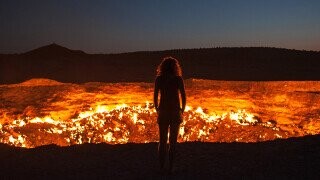Five Fires That Never, Ever Stop Burning

For the past few years, it’s become fairly common to talk about the world being constantly on fire, either figuratively — as a way of discussing the chaos and political turmoil that seems to be particularly potent recently — or as an only slightly exaggerated way of talking about climate change.
But for the section of the population that dislike metaphors and exaggeration, there are also a startling amount of places on Earth that are entirely, literally, constantly on fire. Places like…
The Darvaza Gas Crater, Turkmenistan
Don't Miss
You might know the Darvaza gas crater by its cheery nickname — the Gates of Hell. It’s a big-ass sinkhole in Turkmenistan, 200 feet across and 100 feet deep, that is permanently ablaze. Its exact origins are shrouded in mystery thanks to some missing paperwork, classified information and nobody wanting to take the blame, but the general idea seems to be that, in attempting to access natural gas for energy purposes, Soviet engineers accidentally caused a bunch of land to collapse.
Then in 1971, when it was clear that gas was coming out of it, setting it alight seemed like the safest thing to do, to burn it off rather than allow it to poison the whole surrounding area. It has been burning ever since. In 2014, a National Geographic-funded expedition explored the inferno at the bottom to see if any life could be found there — the existence of bacteria in such extreme conditions could mean similar things could be found on some fairly inhospitable-seeming planets.
And there’s a lot of gas down there. Earlier this year, scientists discovered that methane leaks from Turkmenistan’s fossil fuel fields create more global heating than the entire U.K. That’s pretty fucked.
Burning Mountain, Australia
Also known as Mount Wingen, named after the word the indigenous Wanaruah population use for fire, Burning Mountain is home to a fire that’s been going for an estimated 6,000 years. That makes it by a huge margin the oldest continually-burning fire in the world, its ignition pre-dating pretty much everything in human history. It was lit when much of the world was idly considering moving on from hunter-gathering, burning constantly throughout the ancient world and beyond.
Rather than a flame, it takes the form of a ball of glowing embers within the mountain, thought to be about 30 feet across at any given time and reaching 1,800 degrees Fahrenheit. When Western settlers first arrived there, the assumption was that it was volcanic, but it turned out to actually be a coal seam smoldering away. It’s slowly moving along at the rate of about three feet per year, meaning at any given point there’s a strip of forest being quietly roasted from below.
The Centralia Mine Fire, Pennsylvania
In 1962, a coal mine in Centralia, Pennsylvania that had effectively become a landfill was set on fire. It may have happened spontaneously due to the hot weather, may have been caused by another nearby fire or may have been done deliberately in a bid to clear the tunnels of trash. But however it started, it hasn’t gone out yet.
Attempts to extinguish it were delayed repeatedly by bureaucracy and clumsiness, so by the time anything actually began, the fire had outgrown it. By the 1980s, the town had to be abandoned because it was too dangerous for anyone to live in. Sinkholes were appearing in people’s yards; gas stations’ underground tanks were slowly boiling. The endeavor of attempting to salvage Centralia became too expensive, and the townspeople were instead offered cash to leave. It’s now a ghost town, still on fire. Estimates based on how much coal is still down there suggest it will be at least 250 years before Centralia burns itself out.
Yanartaş, Turkey
Thought to possibly have been the inspiration for the flaming Mount Chimaera in The Iliad, the mountainside of Yanartaş in southwestern Turkey is peppered with vents spouting out an unusual combination of natural gases that burn constantly. It looks like dozens of unattended campfires, which may have been burning for 2,500 years.
While in Homer’s telling it was home to a monstrous fire-breathing lion-goat-snake hybrid, these days you’re more likely to encounter tourists roasting marshmallows in the flames for the purposes of Instagram.
Jharia, Jharkhand, India
There are a lot of former mines in India and China that have turned into perpetual fires due to what the Smithsonian calls “poverty, old unregulated mining practices and runaway development.” Essentially, the industrial revolution came to these regions later, creating a dangerous gold rush situation for which many people paid highly.
Jharia, an area of the city of Dhanbad, sits on top of an estimated $12 billion worth of coal, so there are around 30 mines in the region. Most of them extract “prime coke coal,” a perfectly legitimate type of coal primarily used in blast furnaces but that you wouldn’t want to discuss near the police.
However, the Jharia coalfield has been, y’know, on fire since 1916. Well over 40 million tons of coal has been burned there since, a neverending environmental nightmare that’s made parts of the area completely uninhabitable. It’s led to mines collapsing, houses disappearing due to subsidence, widespread respiratory and skin conditions and, ultimately, mass relocation. The ground is hot, smoke spews from holes and flames occasionally lick up as if from a world below.
This has also meant a lot of the coal is unreachable, as getting it would require mining through seams of red-hot, equipment-destroying material. The city is sitting on a fortune, and yet is nowhere near it. God damn it — that’s a whole layer of burning with frustration slapped on top of the actual, physically, on-fire, burning element of it all.